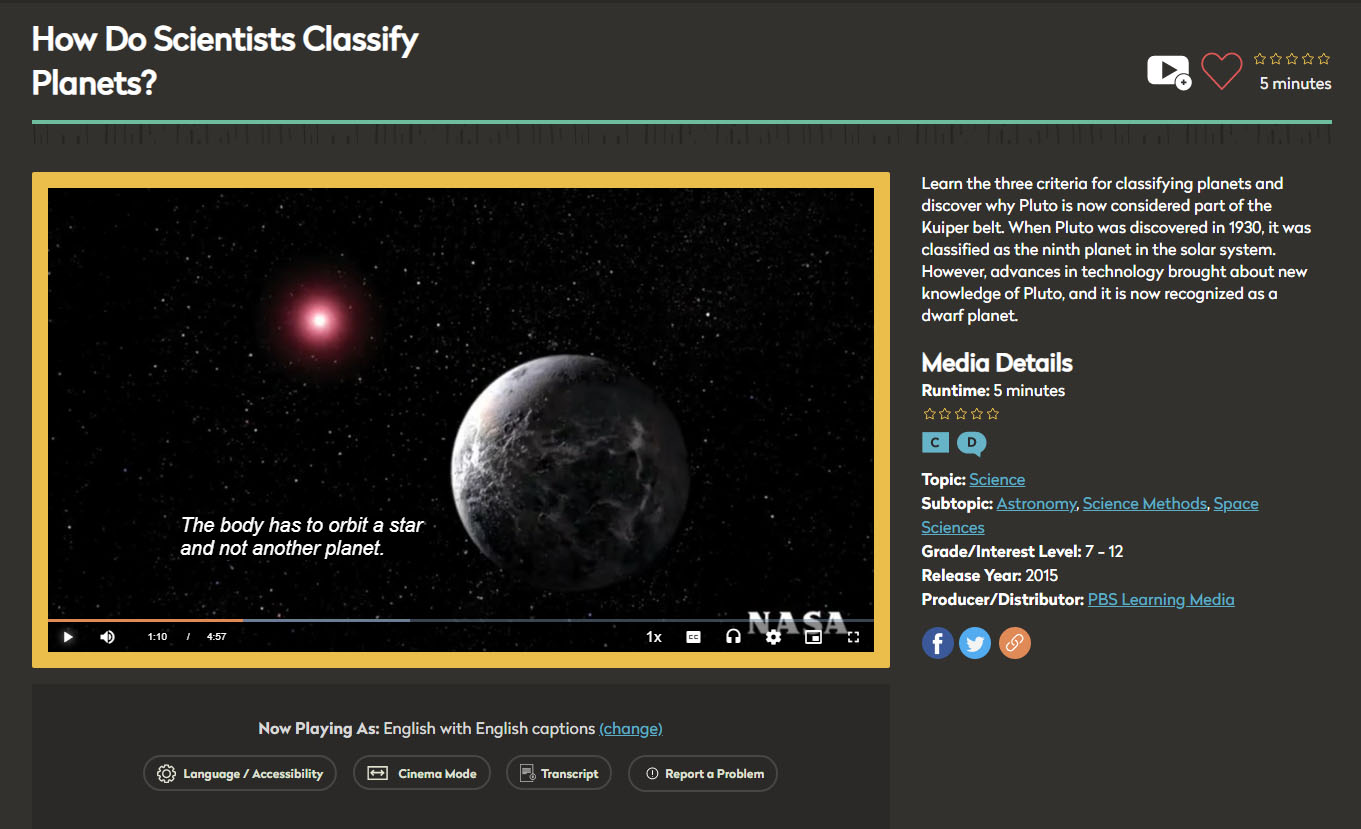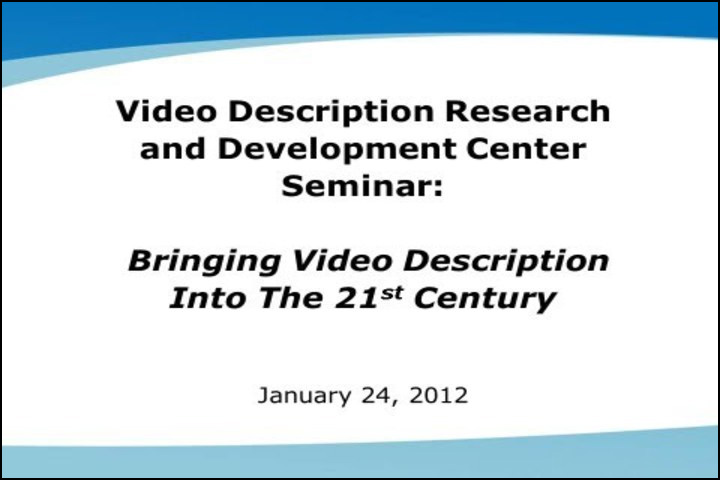99 Learning Center results found.

Blindness Sector Report on the 2012 ABC Audio Description Trial
This collaborative report, prepared by Blind Citizens Australia, Vision Australia, ACCAN, and Media Access Australia, aims to highlight the consumer experience of the audio description (AD) technical trial on ABC TV in order to persuade the Australian government to support a permanent AD service. Attempts to reflect the high demand for AD by consumers and outline the benefits of AD.
about research, description

DCMP's Player-Based Captions, ASL, and Audio Description
To ensure that all media in DCMP's video library is always accessible, captions have been "burned in" or "open," meaning the captions are physically part of the video. Likewise, audio description has been added to each video's main soundtrack. Beginning in April, 2020, captions and description began transitioning to "player-based," meaning that these accessibility features are comprised of separate tracks that can be toggled on and off by the viewer. To continue DCMP's commitment to ensuring each viewing of every video is accessible, at least one accessibility feature will always remain on. All new content will have player-based accessibility upon release, and existing content will gradually switch to player-based as we quality check each one to ensure proper functionality.
From DCMP Help Center

Descriptive Video: Using Media Technology to Enhance Writing
A lesson plan from ReadWriteThink about using description to improve students' written communication skills. This plan focuses on utilization of Disney's popular The Lion King, but teachers can broaden their approach to this lesson by utilizing any one of the hundreds of accessible titles available from the DCMP collection.
about description

Public Service Announcement - Video Description (Spanish-Language Video)
This public service announcement on "Video Description" is brought to you by the Family Center on Technology and Disability and Dicapta. Video description describes providews audio-narrated descriptions of the images in a program/video for viewers with blindness or low vision. For more information in Spanish about video description, please visit www.dicapta.com/descripcionhoy.
about spanish, description

The Adlab Project: And Some Ideas on Audio Description
A PowerPoint report of the European Erasmus Multilateral Lifelong Learning project's goals to: 1) Create authoritative guidelines and/or proposals for the AD profession/industry in all Europe; 2) Develop curricula for universities in Europe: both for entertainment and for instruction; 3) Train audio describers and audio describer trainers; 4) Sensitize and influence decision-makers; 5) Create useful connections with the television industry and with the service providers. By Chris Taylor, 2013.
about research, description

Screenwriting Tip: Audio Description for the Blind By Eleanor Ball
On her blog devoted to writing tips for screenwriters and novelists, Lucy V. Hay reveals her discovery that description for the blind is an inspiration for writers. The new narration added has to be clear, simple, recognizable, and succinct. Listening to it is like attending a scriptwriting masterclass.
about description

Evaluating Alternative Styles of Audio Description in an Animated Comedy
This thesis investigates the impact of conventional and alternative styles of audio description on the blind and low viewers' comprehension, entertainment experience, trustworthiness of the audio description narrative, and style preference. Author John Riccio asked 18 blind and low vision participants to watch three episodes of the television show Odd Job Jack in a single audio description style. Each participant was asked to complete a pre and post study questionnaire, and a post episode questionnaire at the completion of each episode. Results indicated that the alternative style of audio description provided better understanding, entertainment value, and is more trustworthy.
about research, description

Bringing Video Description into the 21st Century Webinar
This an archive video of the Video Description Research and Development Center webinar #1 - Bringing Video Description Into The 21st Century. The webinar occurred January 24, 2012. Topics in this webinar include: (1) A teachers' guide to using video description; (2) A comprehensive overview of resources for obtaining described materials; and (3) A sneak peak at the description technologies of the future being developed at the VDRDC. Presenters included Dr. Joshua Miele, Director of the VDRDC; Jim Stovall, President of Narrative TV Network; Jason Stark, Director of the Described and Captioned Media Program; Joel Snyder, Director of the Audio Description Project at the American Council of the Blind; and Emily Bell, Multimedia Manager at CaptionMax.
about webinar, educators, description, technology

How Description Can Be Effectively Used in the Classroom
Emily Bell, Multimedia Manager at CaptionMax, gathered feedback from teachers who have used described educational videos in the classroom. In this short video clip, she provides six tips for getting the most from the programming. Ms. Bell presented these tips in the January 2012 VDRDC webinar "Bringing Video Description Into the 21st Century."
From Emily Bell about educators, description

A Comparative Study of Audio Description Guidelines Prevalent in Different Countries
Comparison of description guidelines by six different countries: Spain, Germany, France, United Kingdom, Greece, and America. Though, in principal the guidelines and/or standards are very similar in nature, there are minor differences in a few of the recommendations. These differences could potentially be because of different formats of film/television programming being produced in different countries, different ways of watching films/television programs, cultural differences leading to relative levels of understanding of set-ups specific to different films/television programs, and also different ways in which audio description is made available i.e. through products specifically targeted at blind or partially sighted people or as an alternative sound track via mainstream services. Royal National Institute of Blind People, 2010.
about research, description

Contrasting Visual and Verbal Cueing of Space: Strategies and Devices in the Audio Description of Film
A study by Maija Hirvonen, University of Helsinki, Finland, in 2012. Analyses how shot distance is reflected in audio description by syntactic and semantic means. Four different-language audio descriptions of two films were utlilized, contrasting the visual source text with the verbal translation. The study aims to show how audio description can make use of diverse representational strategies and linguistic devices in rendering shot distance. These strategies and devices could be used purposely to compensate for visual cues so as to give an idea of space similar to that conveyed by the visual representation.
about research, description

Descriptive Children's Television: Bridging the Gap for Blind Kids While Benefiting All Kids
While some research has been conducted about the benefits of description and blind adults, no empirical data have been collected relating to benefits of description for children. In this paper by Melanie Peskoe, literature has been reviewed to discuss (1) the emerging trend toward educational programming for preschool-aged children, (2) the various theories about how children learn, and (3) the implications of description for both blind and sighted children. This paper serves as a foundation for future, needed research on this topic and calls for attention to be paid to both the social impact of description as well as the methods used for deciding when, what, and how to describe.
about research, description


Feasibility Study Relating To The Establishment Of A Descriptive Loan Service
This 1992 study was conducted by the Captioned Films/Videos Program (now the DCMP), with the principal investigator being Leo E. Persselin under the direction of the National Captioning Institute. It was submitted to the U.S. Department of Education (ED), Office of Special Education and Rehabilitative Services, and required by the ED as part of the Contract No. HS01005001 awarded to the National Association of the Deaf in 1991. The objective of the study was to: "Conduct a comprehensive study that will provide the funding agency with recommendations on any future loan service of video-based materials for visually impaired persons." Some conclusions and recommendations of the study included the following: (1) the existing accessible media are not exclusive of one another nor of a future loan service, (2) encouragement and support should be extended to all who have something to offer in expanding access to descriptive video, (3) all reasonable avenues should be explored for establishing a descriptive video l...
Read More
about research, description